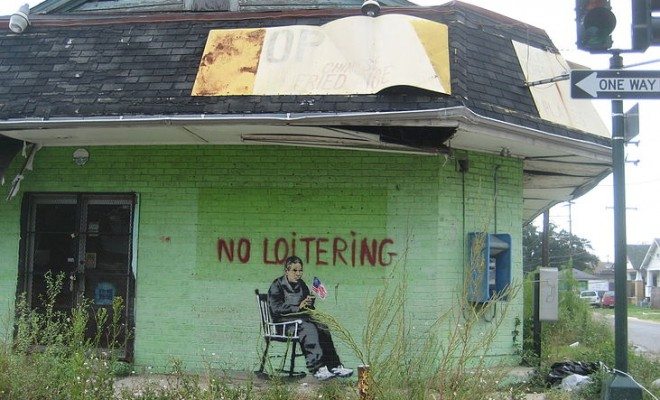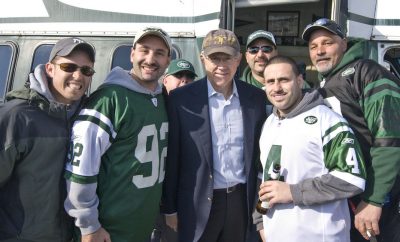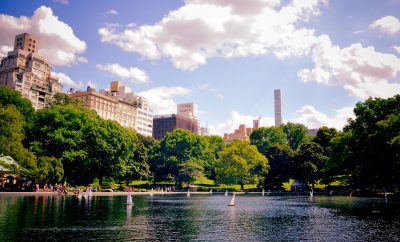
Society and Culture
What did we Learn from Banksy?
“I have a confession to make,” Patti Smith said on a dimly lit stage, “I am Banksy.”
On May 19 2014, the ‘godmother’ of punk rock presented the Webby Award Person of the Year to Banksy, the street artist, activist, and all around prankster, who in October 2013 took New York by force in a month-long residency engaging the city with tags and stunts. The eighteenth annual ceremony took place at Cipriani Wall Street (once home to the New York Stock Exchange, and headquarters to the National City Bank), celebrating the twenty-fifth anniversary of the Internet, honoring “excellence on the internet” – a distinction that becomes evermore dubious in America post net-neutrality. The elusive street artist did not make an appearance of course, but he did issue a video response summarizing his month in New York. In October 2013, the video begins, Banksy became New York City’s Artist in Residence, “an honor so prestigious he made it up and awarded it to himself.”
The month-long tour began October 1, 2013 when the artist vowed to produce a new piece of work every day somewhere in the city. Banksy’s website named the residency “Better Out Than In,” which, as Roberta Smith of the New York Times pointed out, “may seem to elevate the streets and the outsider artist above insiders and their pristine galleries, but it is also a crude British version of ‘gesundheit,’ except for expulsions other than sneezes.” The name evokes the playfulness of Banksy’s aesthetic, which he sometimes uses to convey stark political messages. “This British graffiti artist, purported millionaire, activist, filmmaker and prankster spent the last month roaming the city,” Smith continued, “perpetuating what is — depending upon your point of view — street art, political resistance or vandalism.” Banksy’s art was a social experiment, “using the city as a rat maze into which he dropped different kinds of bait to see how New Yorkers would react.”
What type of political graffiti? For starters, “The Sirens of the Lambs,” was an obvious critique of the meat processing industry; the piece consisted of a delivery truck overflowing with adorable animated heads of sheep and cows, screeching to the public on their way to the slaughterhouse — appropriately driving through Manhattan’s Meat Packing District.
On October 4, the artist made a traditional spay-paint tag in Bushwick, “OCCUPY! The Musical;” another tag he produced on October 23 read, “Today’s art has been cancelled due to police activity.” On October 16, Banksy staged a performance piece where a dirty young man shined the shoes of a Ronald McDonald statue, which frowned down at the wastrel. The piece critiqued the low wages in the fast food industry, and even drew complaints from the passersby for the working rights of the performer.
My favorite piece, however, was a stall that Banksy set up selling original artworks. The art would have totaled half a million dollars; however, “without any of the art hype,” Banky’s recent video explains, “the results — a total take of $420.”
If Banksy’s residency was a series of “social experiments” as Roberta Smith interpreted, what do they tell us about New York — about America? Banksy points out obvious yet controversial social issues such as the ethics of animal slaughterhouses, and wage-slavery of fast food service, but he does so with subtle ironic playfulness, making his art appealing to a popular audience. Banksy invites public interaction, and in doing som discussion of the issues he presents, which I think is the prime value of his dada-esque confluence of political prank and art. The public responded resoundingly to Bansky’s New York odyssey; in October 350,000 people followed Banksy’s Instagram account and spread photos of his art further on Foursquare, Tumblr, Vine, YouTube, and Twitter, where #banksy was used more than 38,000 times during the month. Ultimately, Banksy has demonstrated how social media influences our daily lives, shaping social and political discussions; he presents the intrinsic value of public space, both physical and virtual, as a space for political and social dialogue. As transnational private wealth continues to conquer the public sphere, Banksy ever more so stands out as a beacon of public resistance.
—
Ryan D. Purcell (@RyanDPurcell) holds an MA in American History from Rutgers University where he explored the intersection between hip hop graffiti writers and art collectives on the Lower East Side. His research is based on experience working with the Newark Public Arts Project and from tagging independently throughout New Jersey and New York.
Featured image courtesy of [Infrogmation via Wikipedia]










Comments